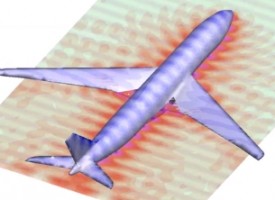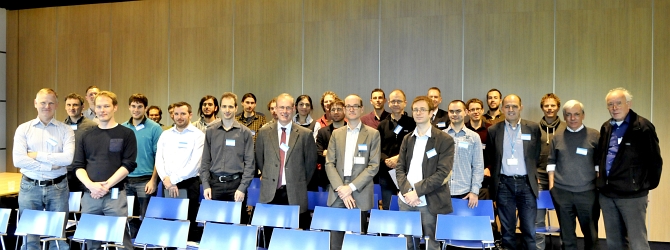
Radar scattering of aircraft
International workshop on numerical methods on the occasion of thesis Elwin van ‘t Wout
Today, November 12, NLR in cooperation with the Universities of Delft and Nottingham organised a very successful workshop on numerical methods for scattering of electromagnetic waves, necessary for the prediction of radar signatures of air planes. Key note speaker was the guru of the field, Prof. Eric Michielssen of the University of Michigan.Prof. Michielssen has travelled to the Netherlands expressly to join the Doctoral Committee of Elwin van ‘t Wout, PhD student in NLR’s Flight Physics and Loads department. Elwin has defended his thesis with success, and has worked towards this goal the last four years under supervision of Harmen van der Ven (NLR), Duncan van der Heul (Delft University, ex-NLR), and Prof. Kees Vuik (Delft University). The title of his thesis is ‘Stability, accuracy, and robustness of the time domain integral equation method for radar scattering analysis.’
Hidden behind this technical title are a myriad of useful applications. Fighter aircraft of the fifth generation are equipped with advanced radar absorbing materials. A veil of secrecy shrouds these materials, but the absorbing mechanism presumably is caused by ferromagnetic particles in the composite structure of the aircraft. The electromagnetic behaviour of these particles exhibits nonlinear behaviour: hysteresis. Common physical models for the scattering of radar waves operate in the frequency domain and are not able to represent these nonlinear phenomena. Elwin has researched time-domain methods which can. Other areas of application are non-cooperative target identification and wide band radar.
Elwin’s challenge was that the time-domain method as described in literature, is unstable. This implies that the method is useless in practice. Elwin has found out how to stabilise the method. Not only has he proven this in the mathematical sense, but countless stable simulations also support his claim. He has also worked on the robustness of the algorithm, which is now suitable for real-life applications. A short video clip of the time-dependent scattering on a passenger aircraft can be seen on NLR’s YouTube channel.
For more information, contact Harmen van der Ven (NLR’s Flight Physics and Loads Department).

INT13 Workshop participants


